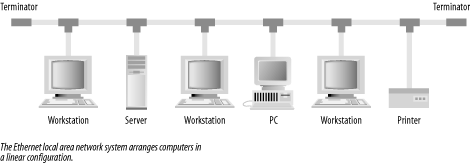Networking
From a practical viewpoint, computer users today usually divide the world of networking into two halves:[105]
- Local area networks
LANs are high-speed networks used to connect computers at a single location. Although the original Ethernet network was a broadcast network that sent high-frequency transmissions over a coaxial cable (see Figure 11-1), today the term Ethernet is widely taken to refer to a twisted-pair network assembled with hubs or switches that can transmit information at speeds of 10, 100, or 1,000 Mbps (see Figure 11-2). Wireless networks that operate over a relatively short range—within an office or home—also constitute “local area networks.” The protocols involved in either case are defined in standards developed by the Institute of Electrical and Electronics Engineers (IEEE).
- Wide area networks
WANs are typically slower-speed networks that organizations use to connect their LANs. WANs are often built from leased telephone lines and long-distance data circuits (which may transit satellite links, microwave connections, and fiber optic cables) capable of moving data at speeds between 56 Kbps and gigabits per second. A WAN might bridge a company’s offices on either side of a town or on either side of a continent.[106] Some WANs are shared by several organizations.

Figure 11-1. Ethernet local area network
Figure 11-2. 100Base-T local area network
Some authors ...
Get Practical UNIX and Internet Security, 3rd Edition now with the O’Reilly learning platform.
O’Reilly members experience books, live events, courses curated by job role, and more from O’Reilly and nearly 200 top publishers.

